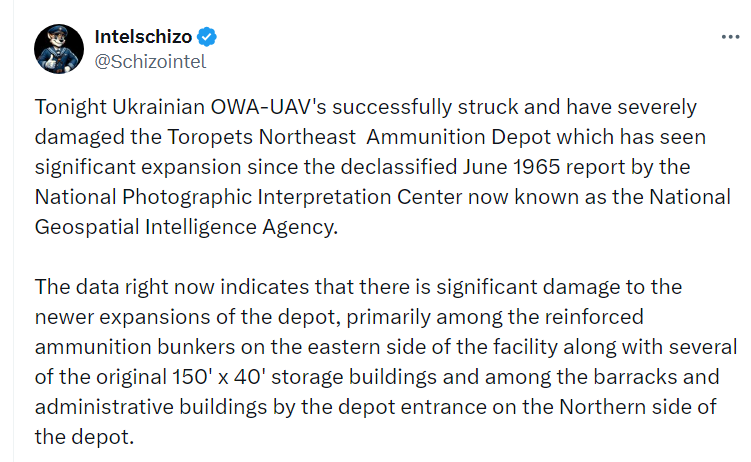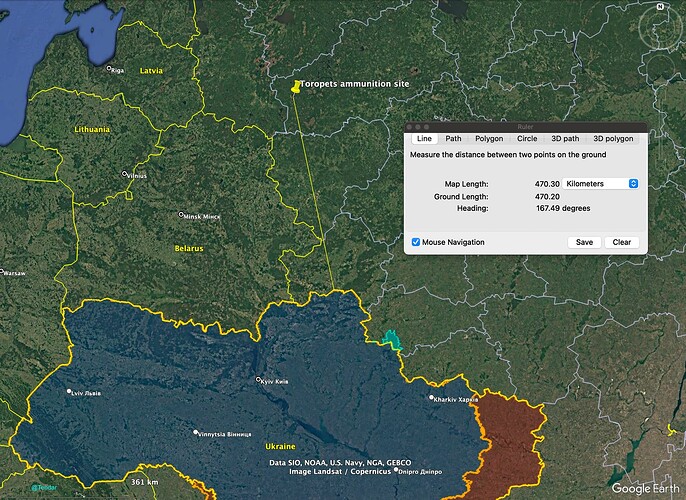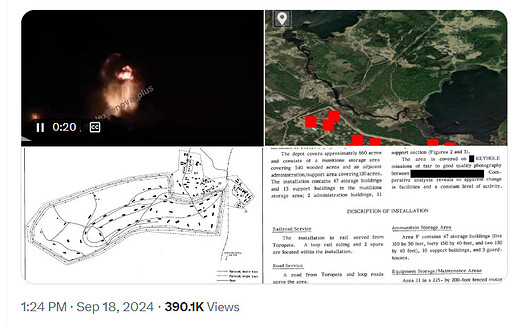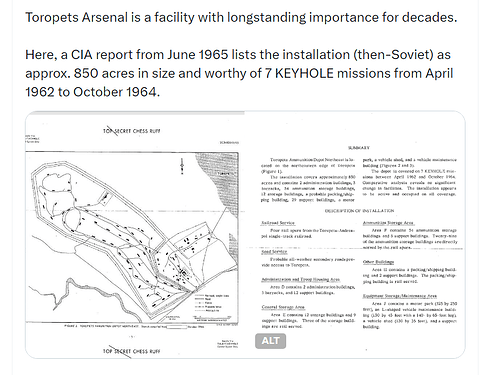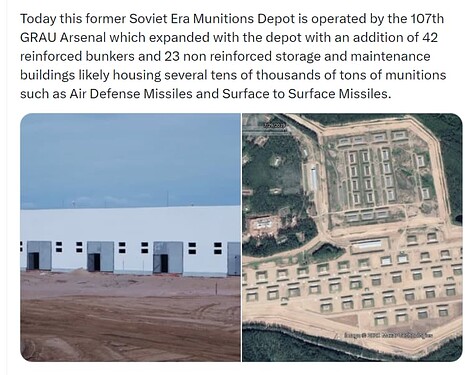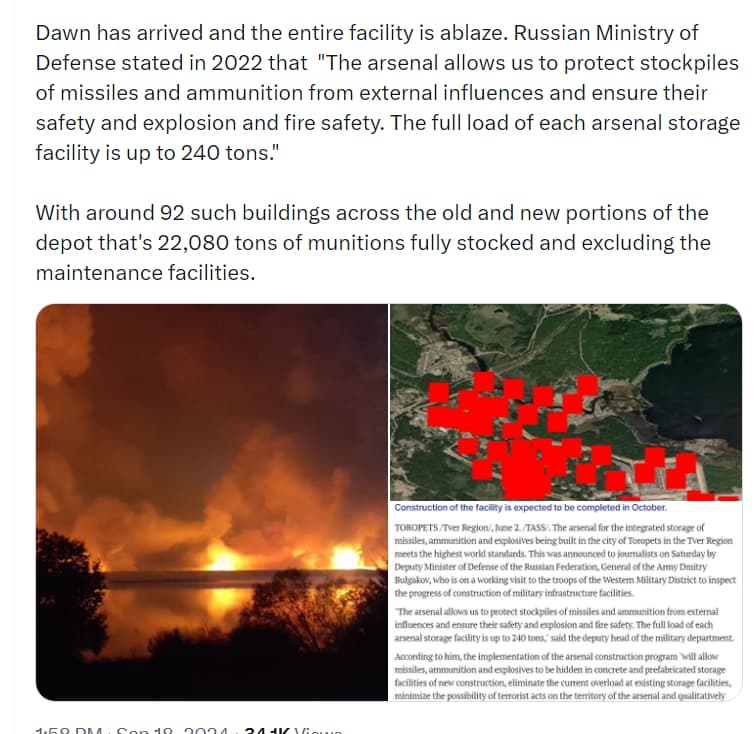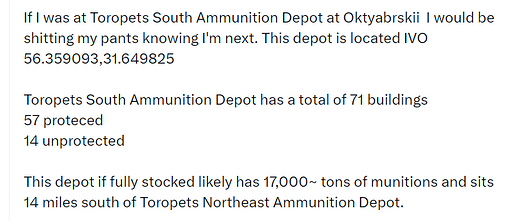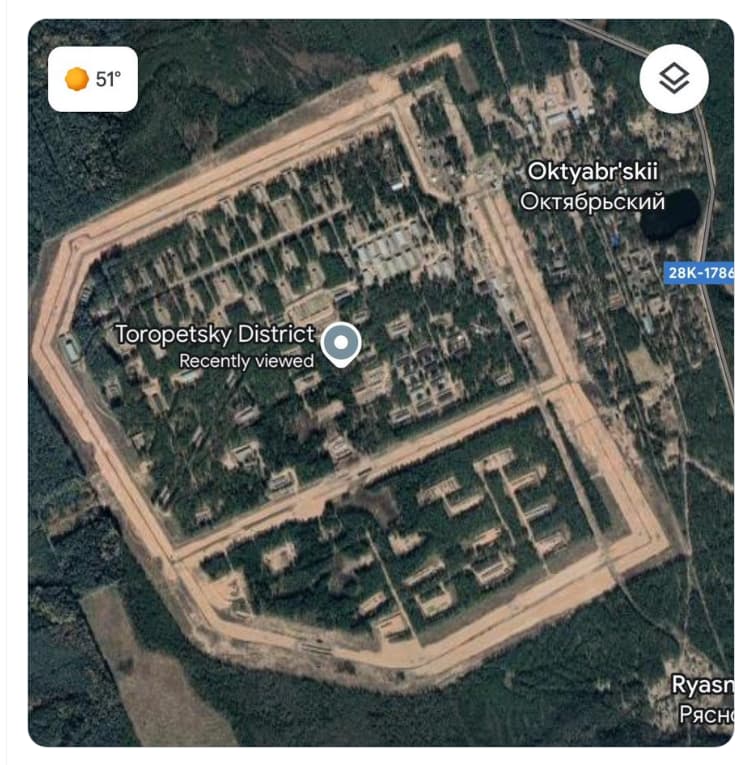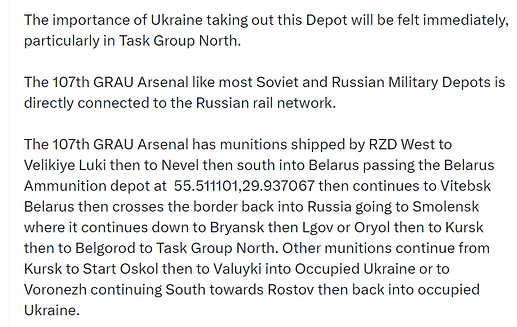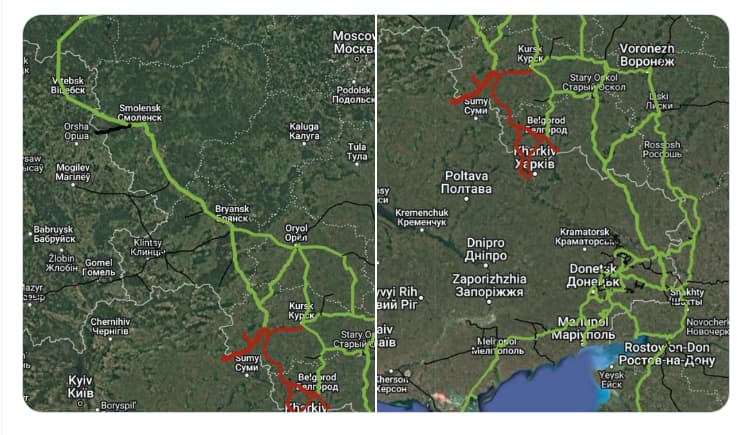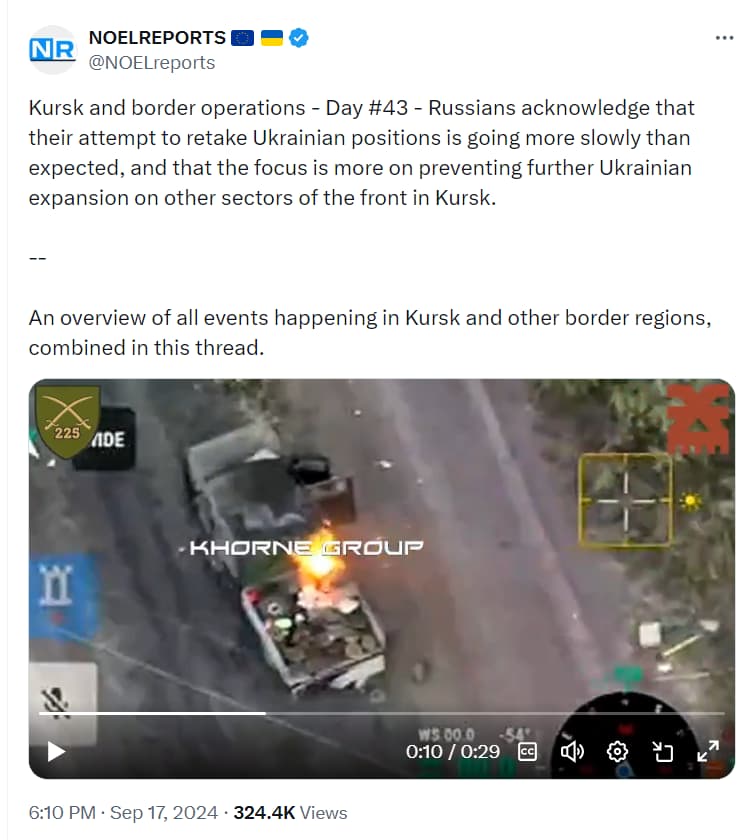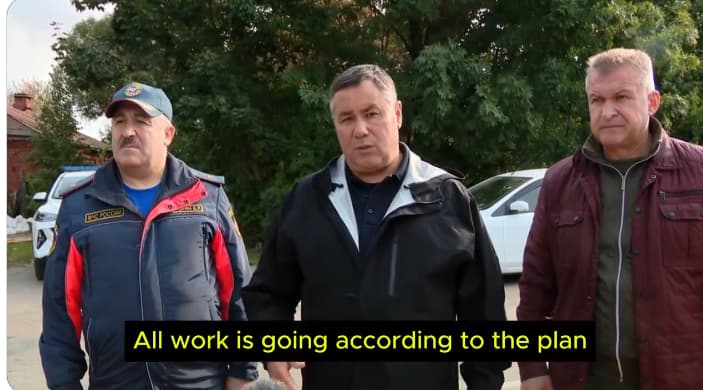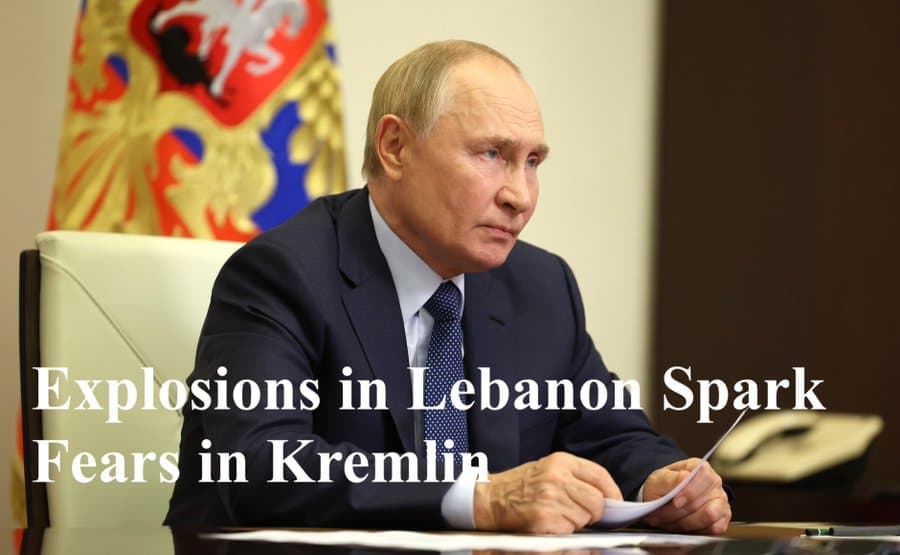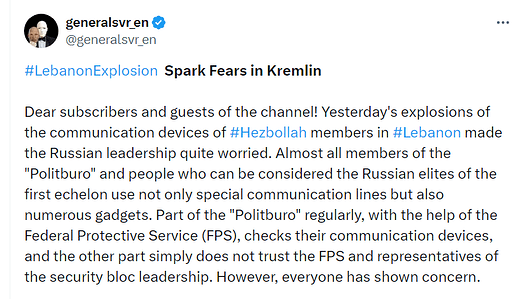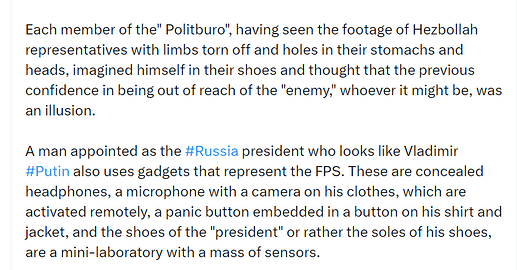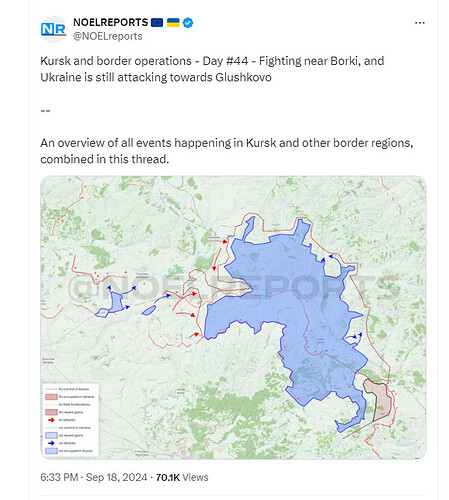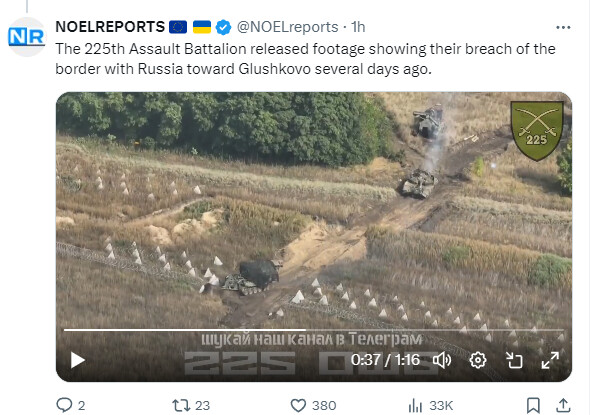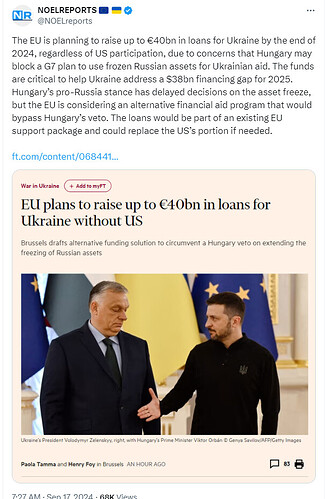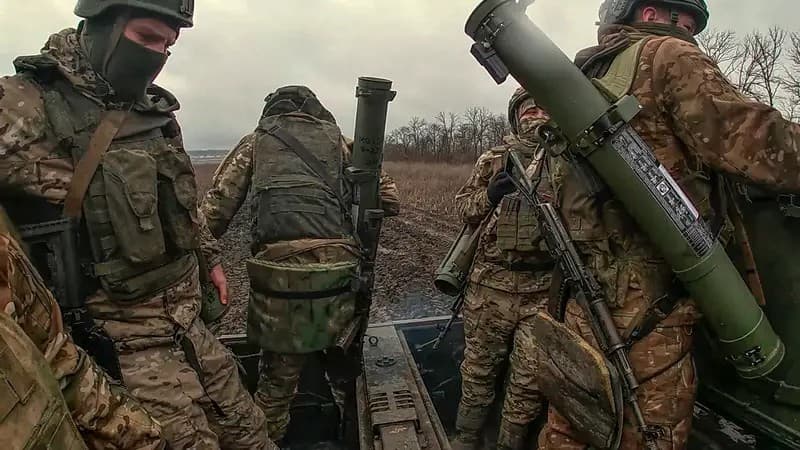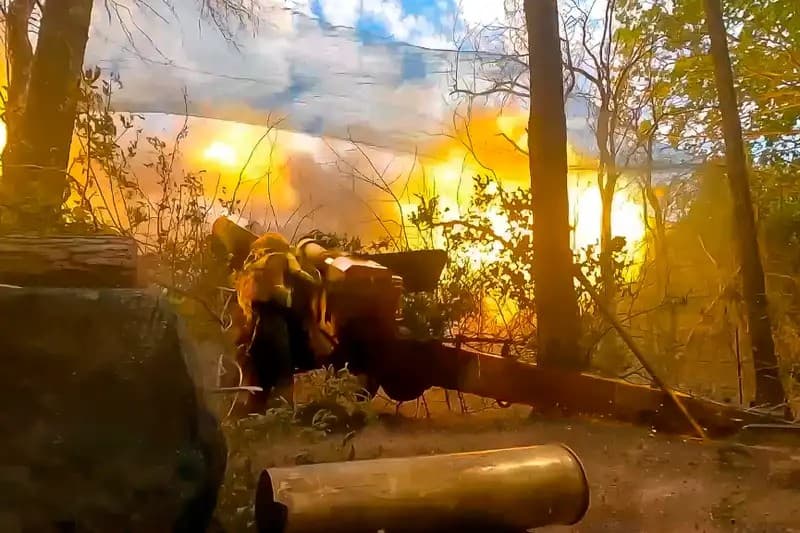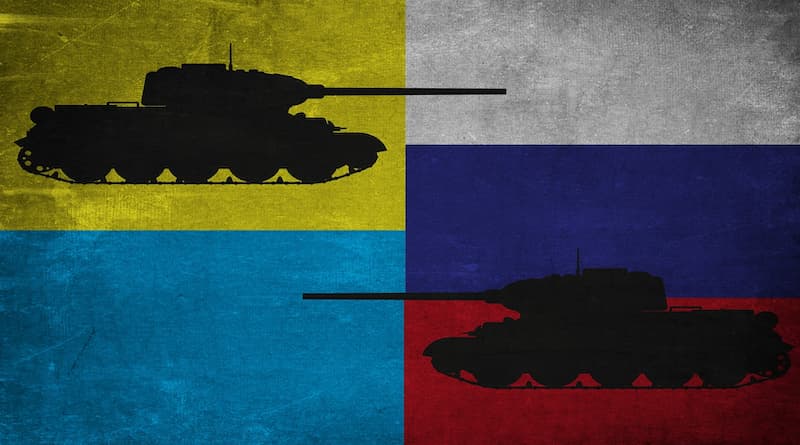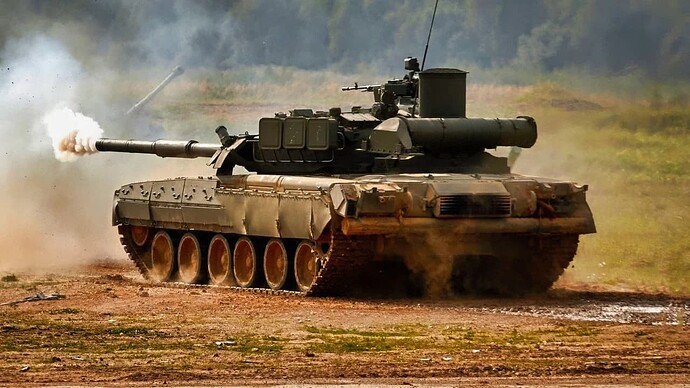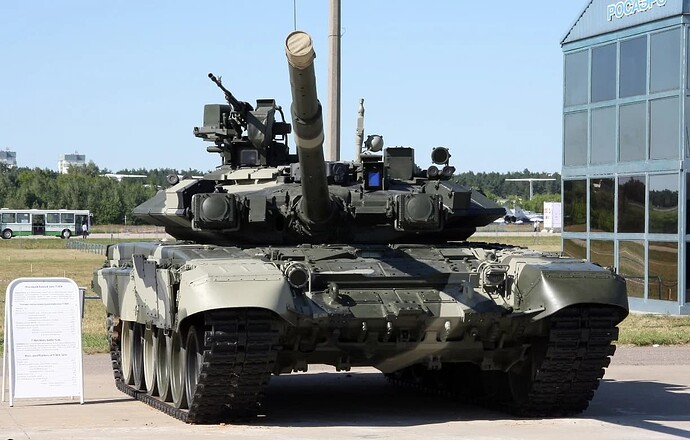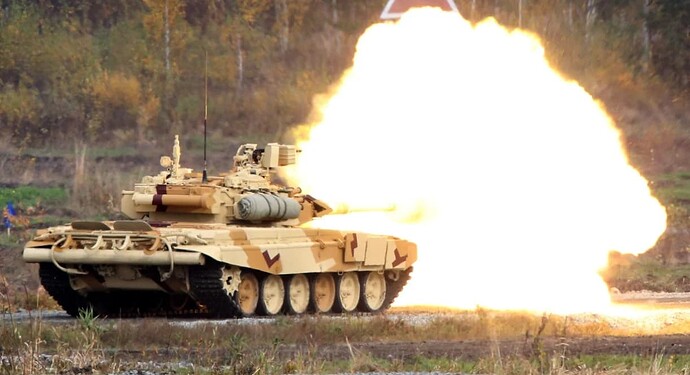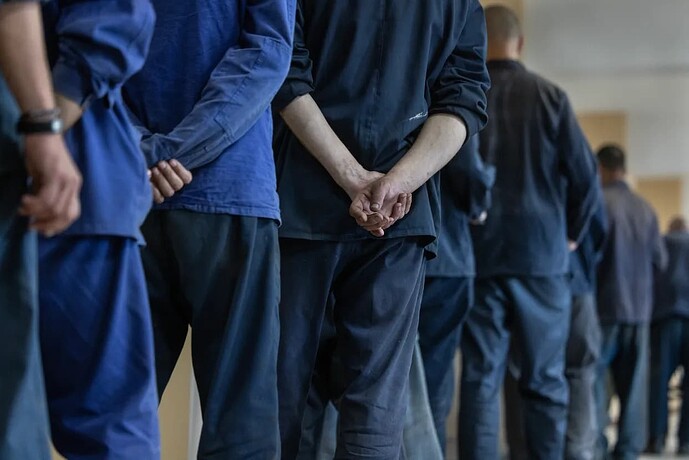More info on Toropets Northeast ammunition depot
Thanks ChatGPT… ![]()
No, an explosion from conventional explosives stored next to a thermonuclear device would not trigger a nuclear explosion.
Thermonuclear devices (hydrogen bombs) are highly complex and require very specific conditions to detonate. They rely on a two-stage process:
- Primary Stage: A fission bomb (similar to an atomic bomb) is detonated, which generates the high temperatures and pressures needed.
- Secondary Stage: The energy from the fission explosion compresses and heats the fusion fuel (often isotopes of hydrogen) to start nuclear fusion.
For a thermonuclear device to detonate, the conventional explosives inside the bomb must be precisely shaped and detonated in a very specific sequence to compress the fissile material. An uncontrolled explosion nearby—such as from conventional explosives—would damage the intricate components of the nuclear device and prevent it from achieving the necessary conditions for nuclear detonation.
While nearby conventional explosives could cause damage or even spread radioactive material if they ruptured the device, they would not result in a nuclear explosion. Triggering a thermonuclear detonation requires much more than just an external explosion; the process must be deliberate and precisely controlled.
Lol. The Tver governor giving a media interview with the continuous sound of munitions exploding in the background is the real life (audio) manifestation of The Naked Gun meme…
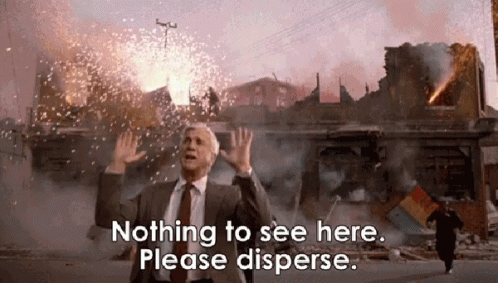
As an IAEA member, Russia also needs to tick boxes on storage and safeguards, along with other IAEA members storing nuclear materials, military and other

That is yesterday’s overview, here is todays version:
https://x.com/NOELreports/status/1836322711338992069
This is a great video showing how they breached the russian minefields, dragons teeth and ditches with their engineering vehicles. Kind of surprised they released it, shows how easily they got through.
Can’t recall seeing this posted? Good strategy by the EU
https://x.com/NOELreports/status/1835792759103357404
https://x.com/Gerashchenko_en/status/1836350530471215443
“We almost shot you. We thought you were ukrops [Ukrainians].”
A brilliant operation recorded by the camera of one of the soldiers of the 12th Azov Brigade, during which the our Warriors pretended to be Airborne Forces reconnaissance and went to the Russian positions.
The finale is worthy of an Oscar!
Russia’s oil revenue has plunged as global crude prices tumble
Sep 16, 2024, 10:21 PM GMT+8
- Russia’s oil revenue has plummeted as global crude prices fall.
- Oil sales dropped to $1.44 billion in the week ending September 8, per data cited by Bloomberg.
- The price of Russia’s flagship crude blend is down 20% from its peak.
Russia’s oil business has taken a hit, with the nation’s crude revenue dropping to its lowest levels in seven months, according to Argus Media data cited by Bloomberg.
Moscow, which relies on crude sales for a big chunk of its revenue, saw the gross value of its oil exports drop to $1.44 billion in the week ending September 8, down from $1.52 billion netted the prior week, the outlet reported. That’s the lowest amount Russia has netted from crude exports since January, despite the nation pumping out 40,000 more barrels of oil a day over the last week.
The decline has largely been fueled by plunging oil prices as the demand outlook falters amid predictions of a recession in the US, while US producers continue to pump record amounts of crude.
Urals crude, Russia’s flagship oil blend, has edged lower to $67.61 a barrel, down around 20% from its peak in the spring of this year.
Russia is also selling less oil than it did in the prior years, thanks to weaker demand from its Asian customers and oil pipeline disruptions to Hungary in August. Russia’s four-week average sales volume slumped to 3.13 million barrels a day as of September 8, down 30,000 barrels a day from the prior monthly average.
Observed Russian crude shipments to Asia, in particular, dropped to an average 2.92 million barrels a day in the month over that time frame, around 10% below the average shipped earlier this year, the report said.
Russia is set to make even steeper oil production cuts later in 2024, as part of OPEC’s goal to boost crude prices. The nation is planning to ramp up production cuts in October and November to make up for producing more than it promised earlier in the year, Russia’s Energy Ministry said in a post on Telegram, though it didn’t clarify how much further it would cut.
Seems there might be more than two Russian spies in the ADF.
Ukraine fury as Australia offloads military gear on ‘eBay for weapons’
By
September 18, 2024 — 7.40pm
Decommissioned Australian military equipment keenly sought by Ukraine to help its fight against invading Russian forces is being sold for recreational use on eBay-style auction websites, angering the Ukrainian diaspora and sparking calls for an overhaul of Defence Force disposal policies.
The federal government has rebuffed repeated entreaties to send hundreds of Chinese-made surveillance drones to Ukraine that were grounded because of security concerns but work perfectly and have played a crucial role in saving Ukrainian soldiers’ lives.
Ex-military vehicles being sold on Facebook.
The Ukrainian-Australian community was bitterly disappointed earlier this year when the government opted to dismantle and bury its grounded fleet of MRH-90 Taipan helicopters rather than take up a formal request to donate them to the Ukrainian army.
The Pickles Auctions firm has monthly online auctions of decommissioned military equipment, with the next sell-off slated for early October.
In recent months, the firm’s Facebook page has invited “off-road enthusiasts” to bid on decommissioned army long-range patrol vehicles, troop carriers and Land Rovers, saying “there’s a vehicle to suit every adventure”.
An ex-military vehicle being sold on Facebook.
One of the long-range patrol vehicles – used by Special Air Services soldiers in the Afghanistan and Iraq wars – reportedly sold for $113,000 last year.
Colin Werner, the general manager of Australian Frontline Machinery, the sole contractor for the resale of ADF equipment, said in an interview this year that ex-army Land Rovers bought at auction were usually used as campers or for off-road driving, while larger vehicles were typically used for commercial purposes.
Kateryna Argyrou, co-chair of the Australian Federation of Ukrainian Organisations, said it was “short-sighted and baffling” to see retired Australian Defence Force (ADF) cargo trucks, troop carriers and inflatable boats for sale online when they could be put to use on the battlefield.
“Our community is in touch with frontline troops every day, who tell us these ex-ADF platforms are exactly what they need,” Argyrou said.
“Ukrainian soldiers are outnumbered, exhausted and working with whatever they are given, so it’s upsetting this equipment hasn’t been considered for Ukraine … The government says its policy goal is to empower Ukraine to win on its own terms, but Defence has simply carried on with business as usual by auctioning equipment off to the highest bidder.”
Kateryna Argyrou, co-chair of the Australian Federation of Ukrainian Organisations, said the Ukrainian diaspora was upset that retired military gear was not being sent to the battlefield.
Retired army major-general Mick Ryan said it was “ludicrous and frankly mean-spirited” that ex-military equipment was being sold to motoring enthusiasts rather than offered to Ukraine.
Former army chief Peter Leahy, however, questioned how useful many of the older vehicles up for auction would be to Ukraine because they lacked sufficient armour.
A report released by the Senate’s foreign affairs and defence committee this week called for the government to adopt “a default position that Defence materiel being retired or otherwise disposed of will be gifted to Ukraine unless there is a compelling case against this for an individual asset”.
Liberal senator Claire Chandler, who chaired the inquiry, said: “Ultimately, if the Ukrainians believe retiring equipment can be used effectively by their forces, we should be providing it to them rather than disposing of it.”
Long-range patrol vehicles used by Australian soldiers in Iraq and Afghanistan, pictured on the right, are being auctioned online rather than provided to Ukraine.
The committee also called for the Australian embassy in Kyiv to be reopened and the appointment of a co-ordinator-general to oversee Australia’s support to Ukraine across all agencies.
A Defence spokeswoman said: “Gifting to Ukraine is a prominent consideration in the disposal of surplus Defence assets and equipment. Australia is working closely with the government of Ukraine to ensure we are providing practical assistance that is making a difference.”
Ukraine is trying to hold back a Russian counter-offensive in the Kursk region, after Ukrainian troops made a surprise incursion into Russian territory last month.
Argyrou, of the Australian Federation of Ukrainian Organisations, said she was baffled the government had not agreed to offer any discontinued Chinese-made surveillance drones to Ukraine despite the technology playing a pivotal role in the conflict.
A single DJI drone the Ukrainian-Australian community bought and sent to the front had saved an entire unit by alerting Ukrainian soldiers that they were about to be attacked by a nearby Russian unit, she said.
Defence last year said it had grounded its fleet of about 450 DJI drone devices after concerns were raised about the company’s links to the Chinese military and state surveillance, a move quickly followed by other government agencies.
In its submission to the Senate inquiry, the federation said: “Software and hardware patches for these drones have been developed in Ukraine which makes them safe to use and the [federation] reached out to the Australian government with a request to consider transferring the DJI drones to Ukraine where they would save lives.
“Despite our repeated pleas to send these drones to Ukraine, it was decided to dispose of them instead.”
Ukraine’s ambassador to Australia, Vasyl Myroshnychenko, said: “If the government was willing to provide these drones to Ukraine, we would be happy to receive them.”
Ukraine war analyst says Russia keeps surprising him with just how bad its soldiers are: ‘The bar is very, very low’
Sep 18, 2024, 7:21 PM GMT+8
- The level of training for Russian forces has gotten progressively lower throughout the Ukraine war.
- A war expert said he is repeatedly surprised by “the new depths of how poor the Russian individual soldier quality is.”
- “The bar is very, very low at this point,” he said.
A Ukraine war analyst told Business Insider that while watching this conflict, Russia has continually surprised him with how poorly trained its soldiers are. Even when he thinks they can’t get any worse, they somehow find a way.
“I find myself being surprised with the new depths of how poor the Russian individual soldier quality is,” George Barros, a Russia analyst at the Insitute for the Study of War, a US think tank, said.
Each batch of new recruits gets progressively worse as Russia rushes them off to battle. He said that when it comes to Russian soldier quality, “it’s becoming really difficult for me to see what other additional shortcuts they could take other than maybe deploying just people unfit for service,” such as people with disabilities or who are too old.
“But the bar is very, very low at this point,” he said.
Captured Russian soldiers, war experts, Ukrainian troops, and Western intelligence have all pointed to Russian troops being poorly trained and treated as disposable throughout the war.
The poor training, coupled with the intensity of the war, has resulted in quick deaths: In October 2022, only one month after Russia announced a mobilization of 300,000 Russian citizens, some of those new soldiers were already dead, having only received days of training before being sent to Ukraine.
Russia’s losses have risen recently as Russian troops continue to suffer from deficiencies in training.
Russian Army soldiers ride their armored vehicle toward positions in Ukraine. Russian Defense Ministry Press Service via AP
US intelligence estimated in December that Russia had lost 87% of the troops it had before the start of its full-scale invasion, meaning it started the new year without the vast majority of its professional army, which had its own problems. It is now largely fighting with a replacement force that it hastily threw together.
Russia’s losses, while they have been high since the start of its invasion of Ukraine in February 2022, appear to have soared in recent months.
The UK Ministry of Defence said in July that more than 70,000 Russian troops were likely killed or wounded between May and June. It blamed “an effective Ukrainian defense and a lack of Russian training” as Russia fought in multiple sectors.
That rate — more than 1,100 casualties a day — appears to have continued, with Ukraine regularly reporting similar Russian losses every day, including reporting 1,140 casualties in 24 hours last Wednesday. Business Insider could not independently verify the reported Ukrainian figures.
In addition to the poor training Russian troops receive, Barros also said the higher Russian death toll was due to Russia running operations at a high tempo across multiple sectors of the front for almost a year now. Russia “has been just sort of sprinting for a very long time,” he said.
Quantity, not quality
In some ways, Russia’s high losses have been part of its strategy: Russia has a much larger population and military than Ukraine, and it can use those soldiers to try and overwhelm Ukraine’s forces.
Barros said that Russia’s “whole theory of victory is based on mass, not individual excellence.”
He said Russia was inspired by the Soviet army victories in World War II: “They won their wars not because of the individual excellence of soldiers or units. It’s because the Soviet Union found a way to be able to wage effective operational war with large masses of essentially uneducated, individually ineffective soldiers, but together with mass, were able to achieve what they needed.”
A Russian soldier fires a 152 mm “Giatsint-B” howitzer
In its invasion of Ukraine, Russia has repeatedly used “meat wave” tactics rooted, in some ways, in the Soviet “Not a step back!” doctrine. These brutal Russian tactics have involved sending waves of untrained, poorly equipped soldiers forward to overwhelm Ukrainian positions before sending more skilled soldiers forward.
Russia has been able to reconstitute and sustain losses, replacing killed or wounded with new recruits, but there are challenges. Russia can’t take severe losses indefinitely.
Russian President Vladimir Putin has not made any attempt to launch a mass mobilization since 2022. Russia experts and Western intelligence have said the move is a politically risky one that he appears unwilling to take.
That limits its pool of new soldiers. Instead, Russia has recruited prisoners, used citizens of allies and partner countries like Cuba, and used men already in military service in a reserve capacity.
Matthew Savill, a military strategy expert at the Royal United Services Institute think tank and a former intelligence analyst at the UK Ministry of Defence, told BI that Russia’s weak response to Ukraine’s attack on its Kursk region, which started last month, may at least partly be because “Russian reserves aren’t as extensive as we think they are.”
If those numbers are accurate, that projects to 400,000 losses in a year.
I dunno about you, but I’m looking at going to Russia for my lunch breaks.
Russians Told To Make Babies During Work Breaks to Help Birth Rate
Published Sep 16, 2024 at 11:06 AM EDT
Russians are being urged to conceive children during breaks at work to help the country’s declining birth rate.
The combination of declining births and rising deaths during Russia’s ongoing war in Ukraine has exacerbated the country’s population crisis. Many are also emigrating due to the war.
The Kremlin in July said it was working to reverse the declining birth rate in the country.
The birth rate “is now at a terribly low level—1.4 [births per woman],” Russian President Vladimir Putin’s spokesman Dmitry Peskov said in July, according to AFP. “This is comparable to European countries, Japan and so on. But this is disastrous for the future of the nation.”
Putin has previously stated the importance of boosting the nation’s birth rate and population, saying that “the preservation of the Russian people is our highest national priority.”
The Kremlin has sought to boost the birth rate by offering tax breaks and cash incentives to families.
Now, Russians are being called on to help reverse the declining birth rate by making babies during their breaks at work.
Health Minister Yevgeny Shestopalov said Russians should “engage in procreation on breaks” during a recent appearance on Russian national television, according to The Mirror.
He told an interviewer that there was no reason why Russians shouldn’t attempt to conceive during the work day.
“Being very busy at work is not a valid reason, but a lame excuse,” he said. “You can engage in procreation during breaks, because life flies by too quickly.”
Asked when people who work 12 to 14-hour days would have time to procreate, Shestopalov replied: “During break times.”
Russia is not the only country seeking to reverse its falling birth rate.
Japan has been grappling with long-standing issues of a shrinking and aging population, and the country’s birth rate fell to a new low for the eighth straight year in 2023. Japan’s parliament earlier this year approved a revision to laws designed to strengthen financial support for child rearing couples or those expecting babies, as well as to expand access to child care services and parental leave benefits.
Meanwhile, North Korea is reportedly punishing doctors who perform abortions and providers of contraceptives with jail time as part of a drive to boost the country’s birth rate.
Edit:
At work, it puts a whole new meaning to my announcement, “I’m going for a farken break.”
Well if they got rid of Putin, that would help their birth rate for a start, he is a walking, talking contraceptive!
Ukraine War Turns Into Russian Roulette - OpEd
September 18, 2024
The UK Prime Minister Keir Starmer met with the US President Joe Biden in the White House on Friday with the question of the use of long-range missiles by Ukraine to hit deep inside Russia on their agenda of conversation. But there were no announcements, nor was there any joint press conference.
Starmer later told the media that the talks were “productive” but concentrated on “strategy” rather than a “particular step or tactic”. He did not signal any decision on allowing Kiev to fire long-range missiles into Russia.
Starmer said no final decision had been taken on the Storm Shadow missiles and hinted that further developments may follow at the gathering of the UN General Assembly later this month. “We’ll obviously pick up again in UNGA in just a few days time with a wider group of individuals,” he said.
One reason for such extreme secrecy is that the US and UK are intensely conscious of the Russian President Vladimir Putin’s explicit warning on Thursday that any use of western long-range missiles to strike Russia “will mean that NATO countries, the United States, and European countries are parties to the war in Ukraine. This will mean their direct involvement in the conflict, and it will clearly change the very essence, the very nature of the conflict dramatically.”
Putin added in measured words: “This will mean that NATO countries – the United States and European countries –- are at war with Russia. And if this is the case, then, bearing in mind the change in the essence of the conflict, we will make appropriate decisions in response to the threats that will be posed to us.”
Admittedly, Putin has given similar warnings before also, but did not follow through even when western weaponry was used by Ukraine with impunity to invade Russia recently. So much so that Biden was plainly dismissive about the latest Kremlin warning, saying, “I don’t think much about Vladimir Putin.”
On its part, Moscow estimates that although no official decision on the matter has been announced, it has already been made and communicated to Kiev, and that Moscow would have to respond with actions of its own.
Deputy Foreign Minister Sergey Ryabkov, Moscow’s point person on the diplomatic track, was quoted as saying on Saturday, “The decision has been made, the carte blanche and all indulgences have been given (to Kiev), so we [Russia] are ready for everything. And we will react in a way that will not be pretty.”
Former Russian President Dmitry Medvedev, who now serves as deputy chairman of the country’s security council, went a step further saying that the West is testing Russia’s patience but it is not limitless. He said Ukraine’s invasion already gave Russia formal grounds to use its nuclear arsenal.
Medvedev warned that Moscow could either resort to nuclear weapons in the end, or use some of its non-nuclear but still deadly novel weapons for a large-scale attack. “And that would be it. A giant, grey, melted spot instead of ‘the mother of Russian cities’,” he wrote on the Telegram messaging app, referring to Kiev.
Putin, in his remark on Thursday once again rejected the Anglo-American sophistry that it is Ukraine that will be using any western long-range missiles and not NATO. He pointed out that the Ukrainian army “is not capable of using cutting-edge high-precision long-range systems supplied by the West. They cannot do that. These weapons are impossible to employ without intelligence data from satellites which Ukraine does not have. This can only be done using the European Union’s satellites, or US satellites – in general, NATO satellites…
“most important, the key point even – is that only NATO military personnel can assign flight missions to these missile systems. Ukrainian servicemen cannot do this. Therefore, it is not a question of allowing the Ukrainian regime to strike Russia with these weapons or not. It is about deciding whether NATO countries become directly involved in the military conflict or not.”
Interestingly, neither Washington nor London has so far refuted Putin’s above explanation and, curiously, it has been expunged altogether from British press reports — fearing, perhaps, that public opinion might militate against such direct involvement by the UK in a war against Russia in a combat role!
Moscow anticipates that the US-UK ploy may be to test the waters by first (openly) using Britain’s Storm Shadow long-range air-launched cruise missile, which has already been supplied to Ukraine. On Friday, Russia expelled six British diplomats assigned to the Moscow embassy in a clear warning that Uk-Russia ties will be affected. Russia has already warned the UK of severe consequences if the Storm Shadow were to be used to hit Russian territory.
What makes the developing situation extremely dangerous is that the cat-and-mouse game so far about NATO’s covert involvement in the Ukraine war is giving way to a game of Russian roulette that follows the laws of Probability Theory.
That is to say, although Russia cannot be defeated or evicted from the territories in eastern and southern Ukraine that it annexed, Washington and London regard that the final outcome of this random event cannot yet be determined before it occurs; it may even be any one of several possible outcomes, and the probability cannot be ruled out that the actual outcome might even be determined by chance.
Apparently, Biden believes that Russia’s current battlefield dominance is a random phenomenon and possible outcomes range from an annihilation of Russian military power to a large-scale disruption of life in Russia and a possible collapse of Russia — at a minimum, the weakening of the Russian hand in any future negotiations. Simply put, the war is now about Russia rather than Ukraine and long-range missiles can be a game changer.
Thus, Biden, with no political constraints working on him anymore, is escalating the war to create new facts on the ground before his presidency ends in January, which may create conditions for permanent NATO military presence on Ukrainian territory and present Russia with a fait accompli.
Such a strategy built on the quicksands of probability is akin to a game of Russian roulette — an act of bravado. Indeed, Biden’s options to support Ukraine are shrinking with each escalation, As the Wall Street Journal puts it, “With only four months left in the Biden administration and little hope of Congress approving additional funding for Ukraine no matter who wins the presidency, the White House is debating how best to help Kyiv given its limited toolbox.”
Equally, Europe’s interest in the war is also waning. European politics is becoming unpredictable with the ascendancy of the far-right in Germany, the crisis of leadership in French politics, the relative decline of EU’s economy vis-a-vis global rivals due to limited innovation, high energy prices and skills gaps, etc. and, of course, the overarching economic crisis in Europe with no end in sight, as brought out starkly in the recent report by Mario Draghi.
Basically, Biden is pre-setting the trajectory of the war beyond next January so that even after his retirement, his policy approach aimed at inflicting a strategic defeat on Russia remains on track. White House National Security Adviser Jake Sullivan said on Saturday that Washington is working on a “substantial” round of further assistance for Kiev. He confirmed a meeting this month between Biden and his Ukrainian counterpart Zelensky.
Sullivan noted that Biden is working to put Ukraine in the “best possible position to prevail” during his final months in office. The bottom line is that Biden’s war strategy is attenuating as “escalation management” while NATO transitions as a direct party to hostilities.
https://www.eurasiareview.com/18092024-ukraine-war-turns-into-russian-roulette-oped/
I’m going to assume that Putin knows, to have a baby making daliance in your lunch break, that as well as young women, you need young men. Young men that are still breathing.
Putin’s Nightmare: Is Russia Running Out of Troops for Ukraine War?
September 17, 2024
The Russian military has suffered significant losses in the Ukraine war, with casualties exceeding 630,000 troops. Despite an impressive force generation capability over 940 days of fighting, Russia is struggling to replenish its ranks.
Summary and 5 Key Points You Need to Know: The Russian military has suffered significant losses in the Ukraine war, with casualties exceeding 630,000 troops. Despite an impressive force generation capability over 940 days of fighting, Russia is struggling to replenish its ranks.
-The Kremlin has used various tactics, including recruiting prison inmates, minorities, and foreign mercenaries, but its recruitment rates appear to be declining.
-Current estimates suggest Russia is recruiting around 1,000 troops daily, a number barely offsetting its high daily casualty rate, which often exceeds 1,000.
-To attract more recruits, the Russian Ministry of Defense has increased sign-on bonuses, making military service more lucrative than many civilian jobs. However, this strategy is costly, accounting for about 8% of federal spending.
Russia’s Manpower Crisis: Are Kremlin Forces Running Out of Troops?
The Russian military is taking extremely heavy losses that very likely exceed 630,000 men.
The Kremlin has been able to replenish its heavy losses until now. However, that might not be the case anymore.
Is Russia Running Out of Troops?
The Kremlin has shown a remarkable force generation capability, feeding the furnaces of war with fresh troops for almost 940 days of brutal fighting. To do so, Kremlin officials have had to think creatively.
At one point, Moscow relied heavily on prison inmates who signed up for service on the frontlines in exchange for promises of freedom. Many died within days at the front. The Kremlin has also been “recruiting” heavily among minorities working in Russia.
In addition, Moscow has been paying hefty sums to mercenaries from across the world, including in Cuba, Mali, and Syria, to fight on its behalf.
However, it is increasingly becoming the case that Russian officials are running out of men to press into service.
“It is likely that Russian military recruitment rates in 2024 have decreased compared to rates achieved in 2023,” British Military Intelligence assessed in a recent estimate on the war.
The Russian military has conscription, but Russian President Vladimir Putin for political reasons has been very careful not to overtly push young conscripts into Ukraine.
“Russian officials suggested in late 2023 that the Russian MOD [Ministry of Defense] was recruiting at a rate of around 1,600 daily. However, publicly cited figures this year put that rate at around 1,000 daily,” British Military Intelligence added. “These figures are themselves probably inflated to an extent.”
Western intelligence estimates put the number of Russian troops in Ukraine, including on the occupied Crimean Peninsula, at around 500,000.
For almost 150 days now, the Russian military has been taking more than 1,000 casualties every day. So despite recruiting more than 1,000 men daily, there is little to no net benefit for the Russian forces, which are used as cannon fodder by their leaders.
For example, over the past 24 hours, the Russian military, paramilitary forces, and pro-Russian separatists took approximately 1,020 killed, wounded, and captured, according to the latest data released by the Ukrainian Ministry of Defense. (Western intelligence estimates largely corroborate Kyiv’s assessments of Russian casualties.) Over the past seven days, Russian forces have taken approximately 8,200 casualties, or about 1,171 losses a day.
To attract more men, the Russian military has been handing out hefty sign-on bonuses. Sometimes, these bonuses are in the thousands of dollars and outstrip anything a potential recruit would make for several months working a job in Russia.
“This has led the Russian MOD to increase sign-on bonuses in August 2024, an increasingly expensive recruitment strategy for Russia. Estimates suggest military personnel payments amounted to around 8% of federal spending in the year to June 2024. Payment increases will nonetheless probably bolster recruitment levels for the remainder of the year,” British Military Intelligence added.
Another take on a story already reported. Read on if interested.
‘A wave of lawlessness’ – returning from war in Ukraine, Russian convicts commit crimes at home
September 17, 2024 4:51 PM
Editor’s note: This story contains graphic descriptions.
Several months after Russian Sergei Kozlov, an assault fighter of the infamous Wagner Group, returned home from the war in Ukraine, he violently killed his 18-year-old partner Daria, who was pregnant with his child.
She was beaten to death, suffering a traumatic brain injury, a broken nose, a liver rupture, and a closed abdominal injury – the description of all 138 injuries took several pages in the case file, Russian state-controlled media outlet Kommersant reported on Sept. 4.
On Sept. 9, the Russian Omsk Oblast Court convicted Kozlov of murder and sentenced him to 19 years behind bars. But this was not his first time in prison.
In 2021, Kozlov was found guilty of severe and minor bodily harm and was supposed to serve 6.5 years in prison. But he was soon recruited by the Wagner mercenary group to join Russia’s war against Ukraine. For his combat achievements, Kozlov was even awarded the medal “For Courage,” Kommersant wrote.
Moscow has been recruiting convicts for its war since the summer of 2022, first under the auspices of the Wagner Group and later under the Russian Defense Ministry. As of October 2023, Russia has reportedly recruited about 100,000 prisoners.
Initially, prisoners, even those convicted of violent crimes, were promised a pardon after completing a six-month military contract. Since January, Russian army recruits drawn from prisons no longer receive pardons but are released on parole, and are expected to fight until the war is over.
Russian POWs are seen living in a prisoner of war detention camp lining up for a meal in the cafeteria in the Lviv region, Ukraine, on Aug. 3, 2023. (Paula Bronstein /Getty Images)
But as many of the convicts have already returned home under the previous conditions, reports of their new crimes appear to be increasing in Russia.
Since the start of the year, Russia has seen a record number of grave crimes in the past 13 years — more than 403,000 — the Russian Verstka media outlet reported, citing the Russian Interior Ministry.
“Among the factors influencing the growth of crime, the Interior Ministry pointed to the war in Ukraine and the return of former prisoners from the front line,” the outlet wrote.
'Wave of lawlessness'
Over the past two years, at least 107 people have been killed, and another 100 have been seriously wounded by Russian war veterans returning from the front line in Ukraine, Verstka said in its investigation published in April.
The majority of the victims were killed by ex-convicts, the outlet wrote.
Mikhail Savva, a legal expert from the Center for Civil Liberties, believes that the current situation in Russia can be described as a “wave of lawlessness” and the “degradation of legal culture.”
But the return of ex-convicts is not the only reason, Savva says.
“Aggression against an independent state is forbidden by international law. So many people in Russia understand that their government violates everything that can be violated,” he told the Kyiv Independent. “Because it is precisely through the disregard for the law that people get the idea that anything is possible.”
According to Savva, the high number of crimes committed by convicts returning from the front line is mainly because Russia recruits prisoners convicted of nearly all types of crimes.
Only those convicted of terrorism, extremism, and sexual crimes against minors are forbidden to be recruited, Savva says. However, most of the verdicts on extremist or terrorist charges in Russia are simply falsified, as the Kremlin uses them to imprison those protesting against its regime, he adds.
“Hence, murderers, serial killers, and others can join and stand under the Russian army flag.” In May, the Moscow Times reported that Russian cannibal Dmitry Malyshev, who was sentenced to 25 years in prison for murder and several other serious crimes, joined one of Russia’s Storm V penal military units.
Malyshev was reportedly recruited to the army together with serial killer Aleksandr Maslennikov, sentenced to 23 years in prison for the “double murder and dismemberment of women.”
In late August, multiple Russian media outlets reported that a former Wagner mercenary, Ivan Rossomakhin, convicted of several crimes, had signed a contract with the Russian Defense Ministry and returned to the war in Ukraine.
Rossomakhin was recruited by Wagner Group in September 2022 while he was serving a 14-year term for murder and theft. By the end of his military service, he was pardoned by Putin, according to Current Time, a Radio Free Europe/Radio Liberty project.
Then in 2023, upon returning from the war in Ukraine, he raped and killed an 85-year-old woman.
While serving his 23-year sentence, Rossomakhin reportedly joined the Russian army again.
Reports of Russian soldiers committing crimes against Ukrainian prisoners of war have also recently increased, with several cases of alleged execution brought by Ukraine to the attention of international organizations.
Ukraine’s Ombudsman Dmytro Lubinets said on Sept. 17 that he had appealed to the International Committee of the Red Cross (ICRC) and the United Nations in response to a photo that allegedly shows the execution of a Ukrainian prisoner of war with a sword.
However, according to Savva, the rise in violence and brutality by Russian troops toward Ukrainians, including prisoners of war, is only partly due to the large number of convicts in their ranks.
“The reason is not that there are many convicts in the Russian army, but that the army is fighting in conditions where war crimes are the norm. In the Russian army, (war crimes) are not subject to punishment. They do not prohibit it,” Savva says.
Ukraine recruits convicts too. How is it different?
In May, Ukraine also began allowing convicts to enlist in the army. However, the eligibility requirements for these prisoners are more stringent compared to those in Russia.
Those serving for premeditated murder, the murder of two or more people, sexual violence, drug production, and crimes against national security are not eligible to enlist.
“There are limitations based on the severity of the crimes,” Savva says. “In Ukraine, for instance, serial killers remain in prisons, unlike Russia.”
He says the whole recruitment process is different, too. Russia does it “en masse,” and most of the convicts have joined the Storm V penal military units. Meanwhile, in Ukraine, different brigades recruit prisoners to fight alongside their other soldiers, which also helps their socialization, Savva says.
While Ukraine has said it’s looking to recruit a total of 20,000 convicts, over 10,000 convicts signed up in Russia last April alone, the U.K. Defense Ministry reported.
“What we are witnessing now in the Russian army is the degradation of it as an institution of order,” Savva says.
